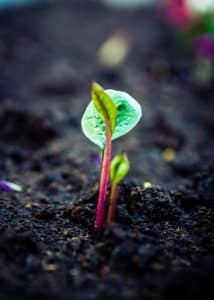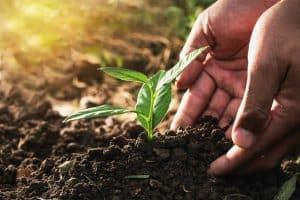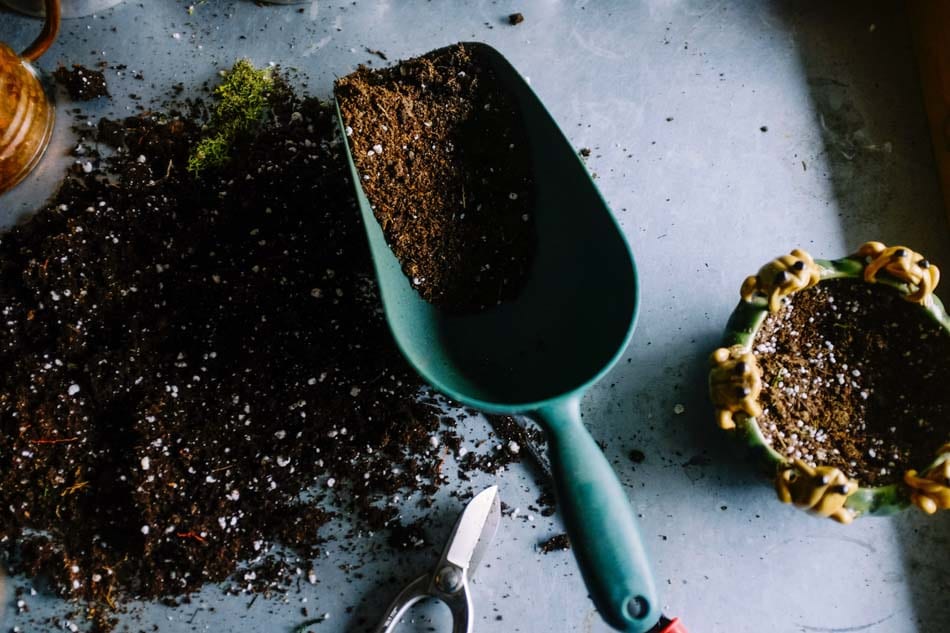If you’re reading this, you probably already know that healthy soil can transform your garden!
All true garden geeks know that quality soil delivers vibrant plant growth, and tastier, more nutritious fruit and veg.
But did you know that improving your soil can save you time? And money? And help the environment?
So if you’re time-poor, budget-conscious, or just love the taste of those heirloom tomatoes (but hate the price), read on!
Whether you are a ‘garden gourmet’, dollar-wise, or want to save the planet, this blog can help!
Click to read what you'll find in this post
Why Does Improving Soil Quality Matter?
Poor soil is a problem for many Perth gardeners.
It can be hard to dig, erode easily, and starve plants of nutrients and water.
Plants can be low-yielding, unattractive, and die young!
This post will help you diagnose what ails your soil, and learn about the antidotes and how to improve your soil.
So put on your white coat and get ready to treat the patient!
Perth Soil Types

Western Australia has too many soil types to discuss in detail here (at least 60!)
We will however:
- introduce you to ‘soil supergroups’ found in Perth
- help identify your soil-type
- share our top ten soil improvement tips.
Soil Supergroups – different types of Perth soils
1. Wet/Waterlogged soils
Wet soils can occur near former swamps, on river plains and near lakes.
They can be fertile, and are usually waterlogged seasonally, rather than all year. They can also have problems, including waterlogged patches, salinity, and metal toxicity.
2. Rocky/Stony Soils
These soils have >50% coarse fragments (pebbles, stones, gravel, boulders and underlying rock slabs).
Problems vary depending on the type/size of stones, and whether soil is sand, loam or clay.
Stony soils can have problematic pH, patchy depth, poor water penetration/retention, and low fertility. They are hard work!
3. Ironstone Gravelly Soils
Ironstone gravelly soils have similar problems, but can suit Mediterranean plants like olives and grapes.
4. Sandy Topsoil
This is the type of soil you will find in a lot of Perth gardens! Most of Perth has sandy topsoil, infamous for its poor absorption and poor retention of moisture and nutrients.
Unimproved sandy soils generally sustain only hardy plants.
The main sandy soil subtypes are:
- Sandy Duplexes (<80cm sand over clay or loam)
- Shallow Sands (sand <80cm over rock/hardpan layer)
- Deep Sands ( sand >80cm deep)
- Sandy Earths (sand grading to loam/clay by 80cms)
If your soil is sandy, try to determine the subtype. If this is too tricky and you just want help to improve the quality of sandy soil in your garden or health of your plants and garden – get in touch with our Perth gardeners today.
5. Loamy Topsoil
Loamy soil is 3cm to 80cm of loamy soil, over rock or clay.
Loam is fertile, retains moisture, and needs little improvement, but isn’t common in Perth.
6. Clay Topsoil
Clay soil is also relatively uncommon.
Depending on subsoil, clay is neutral to acidic, and moderately fertile.
Problems include waterlogging, water resistance, compaction, and drying rock-hard. This constricts roots and discourages earthworms.
Summary of common soil problems
Problem soil may:
- repel water
- lack nutrients or struggle to retain nutrients
- lack microorganisms
- be too acidic/alkaline
- be compacted
- be prone to waterlogging
- erode easily
- be saline
- have toxicities
- be hard work!
What type of soil do I have?
Your location will often determine your soil type.
Perth is on the Swan Coastal Plain, which runs from the coast to Perth hills.
There are three ancient dune systems, and an alluvial floodplain area.
Quindalup Dune System
Some coastal suburbs are on deep sand — the Quindalup dune system. Soil is cream coloured calcareous sand (contains marine shells).
Spearwood Dune System
Central suburbs and remaining coastal areas are on the Spearwood dune system, with predominantly deep yellow sand, or shallow brown sand over limestone.
Bassendean Dune System
Further inland is the Bassendean dune system, predominantly deep pale grey and brown sand.
Pinjarra Alluvial Plain
The fertile Pinjarra alluvial plain runs beside the Perth Hills. It has sandy duplex soils, brown sandy earths, shallow loamy duplex soils and brown loamy earth.
This guide from ChemCentre can help you see where your garden sits in the soil system.
Top Ten Strategies for Soil Improvement

While sandy soils are common, soil types vary, so treatments vary.
We recommend these steps to find the best solution for your soil!
1. Check your soil type
Use the Chemcentre map, and your own observations (or expert advice) to identify your soil. Remember:
- Sandy soil feels gritty and won’t clump, even when wet.
- Clay soil is sticky when wet – it can be rolled into a ‘sausage’.
- Loam is moldable, but not sticky.
- Silt is powdery when dry.
- Peat soil is dark and spongy.
2. Find out what’s missing!
Before improving soil, analyse it!
To save time and money, start by identifying what nutrients are lacking, and check for salt and toxicity.
NOTE: To determine what treatments will be effective, talk to an expert.
A soil analyst or ChemCentre can give a detailed report.
3. Neutralise your soil’s pH level
Before planting, check soil pH using professional analysis, or a home test, and neutralise your soil.
- Acid soil = pH <7.0.
- Neutral soil = pH 7.0
- Alkaline soil = pH >7.0.
A pH of 6.5 will suit most plants, supporting growth of good bacteria, strong nutrient uptake, and healthy earthworms.
Some plants have specific needs however — for example, azaleas need acidic soil — so consider plantings before correcting pH.
Lime raises pH.
Sulphur and nitrogen decrease pH.
4. Add compost / organic matter
Well-rotted manure or compost improves fertility and water/nutrient retention in sand.
Leaf compost reduces compaction/improves drainage in clay.
Most composts and manures are salty, so not recommended for saline soil. Sphagnum peat and plant-only composts are low-salt alternatives.
Vermiculite (a clay) improves water/nutrient retention in sand.
5. Fertilise
Based on soil analysis, add fertiliser with nutrients your soil lacks.
6. Mulch
Mulching improves:
- water retention
- soil temperature
- nutrient uptake
- biological activity.
Laying mulch decreases:
- weeds
- salinity
- pests
- diseases.
It’s important to choose the best mulch for your garden. For example lucerne and pea straw mulches return nutrients to soil, improving soil structure.
Hardwood bark mulch forms rich black soil, improving pH.
Softwood bark mulches, paper and hay are economical alternatives.
7. Improve aeration
Compacted soil lacks oxygen and drains poorly, stunting plant growth.
Mulching and composting help address these problems.
Rice hulls, pumice, biochar and perlite are all effective additives.
Turning soil with a shovel, or aeration by penetrating it with a fork, tiller, or aerator can also help. However, this can be hard on earthworms!
Do your homework, or seek expert advice on what will work best for your soil!
8. Plant ground covers, soil builders or green manures
Ground covers insulate, reduce water loss and erosion, and add organic matter to soil.
Agriculture WA provides useful information on groundcovers.
Green manures are plants grown specifically to be dug back in, to enrich soil before permanent plantings. They improve soil structure and:
- increase water retention/nutrient uptake
- suppress weeds
- reduce compaction and erosion.
Clover, alfalfa, peas, mustard and green manure seed-mixes are popular options.
Soil builders are fast-growing plants that accumulate nutrients. They often have strong roots that break up hard subsoils.
Instead of digging the whole plant back in, foliage is used as an enriching mulch/compost.
9. Encourage earthworms
Earthworms aerate soil, adding essential nutrients.
Worm farms supply nutrients, but your garden should also be ‘worm friendly’.
To achieve this add organic matter like:
- compost
- manure
- coffee grounds
- veggie scraps
Insulate soil, keeping it moist and avoiding extreme temperatures, using:
- mulch
- straw/grass clippings
- cardboard/paper.
Keep pH between 5 and 8.
Try to minimise digging. Let the worms do the work!
10. If all else fails, ask the experts!
Just as soil analysis is sometimes best done by experts, soil improvement can also benefit from expert assistance.
Perth Gardening Experts are happy to help with your soil improvement!
So are you ready to improve your soil?
This blog may have given you all you need to get started on solving your soil problems.
But if you still have questions, or aren’t sure you’re equipped for the task, contact us call us now on (08) 6263 4645.
The friendly team at Perth Gardening Experts will help you work out what is best for you, and how we can help!

